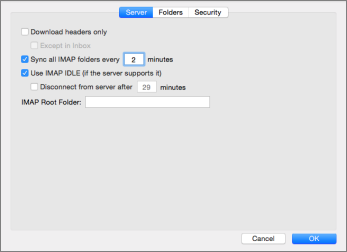In the previous version for Outlook for mac, in order to create a new identity, or profile, you would open up the Database Utility to create the new identity. This has changed for Office for Mac 2016, identities are now referred to as profiles, and the Database Utility is now called 'Outlook Profile. If you didn't select a clean up folder, Outlook will use the Deleted Items folder. By default, Outlook won't clean up categorized, flagged, or digitally signed messages. Change these settings in File, Options, Mail. Open Outlook 2016 to configure your Exchange account. Note: If you've got data from Outlook 2011 for Mac, you need to import these items before adding your Exchange account in Outlook 2016. If you need further assistance, please contact us. If you download and install this package on the affected PC, it appears to run a battery of checks and tests and then will manually create an Outlook 2016 Profile for the affected Office 365 account (using the information that you provide).
URL: Outlook 2016 for Mac uses the term Profiles not Identities. Profile is a set of email accounts and user settings. Outlook Profile Manager is a tool included with Outlook 2016 that allows user to create, delete and set default Outlook Profile. To access Outlook Profile Manager: • Open the Finder menu, and navigate to Applications. • In the Applications window, press Control key, and click Microsoft Outlook to open context menu > click Show Package Contents. • Expand folders Contents and then SharedSupport > Open Outlook Profile Manager. You can perform following actions in Outlook Profile manager: • To create new profile, click on Add icon and type the name for the new profile.
• To rename an profile, double-click on the profile and then type a new name for the itdentity. • To delete an profile, click the profile that you want to remote to select it and then click on Delete icon. • To change default profile click on the profile you wish to make default > click on Action > click Set as Default.
I originally asked this in the 365 forum (but they gave up and said to try here. Using Outlook 2016, 16.0.4229.1024 We have a shared calendar that two people on different PCs cannot add new items to in Outlook 2013 (the New Appointment button is disabled). Neither are using cached mode. We *can* add them through OWA No changes have been made to permissions It did used to work, we just noticed it didn't work today.

All users have the 'Editor' permission on the calendar. (We doubled checked via the Permissions blade in OWA for the account sharing the calendar) What can be done to resolve this? Hi, It only occurs on Outlook, I agree with the moderator in the Office 365 Community forum that it should be an Outlook client issue. For this issue, I found a kb here: Although it's for Outlook 2013, I think it should also work for Outlook 2016.
This problem occurs when Outlook is connecting to your mailbox via MAPI over HTTP. You can check the connection status to verify this. Try the workaround: • Exit Outlook. • Start Registry Editor.
To do this, use one of the following procedures, as appropriate for your situation. • Windows 8: Press Windows Key + R to open a Run dialog box. • Windows 7 or Windows Vista: Click Start, and then click Run to open a Run dialog box. • Type regedit.exe, and then press Enter. • Locate and select the following key in the registry. HKEY_CURRENT_USER Software Microsoft Exchange • After you select the key that was specified in step 4, click the Edit menu, point to New, then select DWORD Value. • Type MapiHttpDisabled, and then press Enter.
• Right-click MapiHttpDisabled, and then click Modify. • In the Value data box, type 1, and then click OK. • Exit Registry Editor.
• Start Outlook. Regards, Melon Chen TechNet Community Support Please remember to mark the replies as answers if they help, and unmark the answers if they provide no help. If you have feedback for TechNet Support, contact. Hi, It only occurs on Outlook, I agree with the moderator in the Office 365 Community forum that it should be an Outlook client issue.
For this issue, I found a kb here: Although it's for Outlook 2013, I think it should also work for Outlook 2016. This problem occurs when Outlook is connecting to your mailbox via MAPI over HTTP.  You can check the connection status to verify this. Try the workaround: • Exit Outlook. • Start Registry Editor.
You can check the connection status to verify this. Try the workaround: • Exit Outlook. • Start Registry Editor.